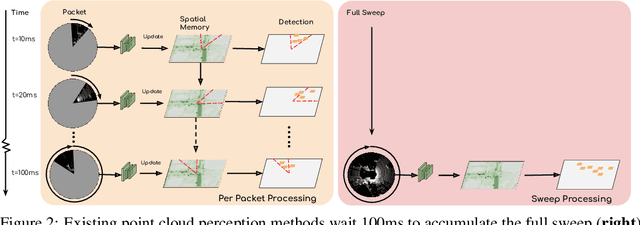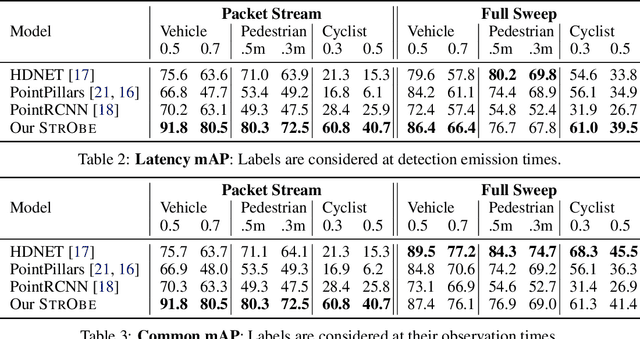Davi Frossard
StrObe: Streaming Object Detection from LiDAR Packets
Nov 13, 2020



Abstract:Many modern robotics systems employ LiDAR as their main sensing modality due to its geometrical richness. Rolling shutter LiDARs are particularly common, in which an array of lasers scans the scene from a rotating base. Points are emitted as a stream of packets, each covering a sector of the 360{\deg} coverage. Modern perception algorithms wait for the full sweep to be built before processing the data, which introduces an additional latency. For typical 10Hz LiDARs this will be 100ms. As a consequence, by the time an output is produced, it no longer accurately reflects the state of the world. This poses a challenge, as robotics applications require minimal reaction times, such that maneuvers can be quickly planned in the event of a safety-critical situation. In this paper we propose StrObe, a novel approach that minimizes latency by ingesting LiDAR packets and emitting a stream of detections without waiting for the full sweep to be built. StrObe reuses computations from previous packets and iteratively updates a latent spatial representation of the scene, which acts as a memory, as new evidence comes in, resulting in accurate low-latency perception. We demonstrate the effectiveness of our approach on a large scale real-world dataset, showing that StrObe far outperforms the state-of-the-art when latency is taken into account, and matches the performance in the traditional setting.
DeepSignals: Predicting Intent of Drivers Through Visual Signals
May 03, 2019



Abstract:Detecting the intention of drivers is an essential task in self-driving, necessary to anticipate sudden events like lane changes and stops. Turn signals and emergency flashers communicate such intentions, providing seconds of potentially critical reaction time. In this paper, we propose to detect these signals in video sequences by using a deep neural network that reasons about both spatial and temporal information. Our experiments on more than a million frames show high per-frame accuracy in very challenging scenarios.
End-to-end Learning of Multi-sensor 3D Tracking by Detection
Jun 29, 2018



Abstract:In this paper we propose a novel approach to tracking by detection that can exploit both cameras as well as LIDAR data to produce very accurate 3D trajectories. Towards this goal, we formulate the problem as a linear program that can be solved exactly, and learn convolutional networks for detection as well as matching in an end-to-end manner. We evaluate our model in the challenging KITTI dataset and show very competitive results.
 Add to Chrome
Add to Chrome Add to Firefox
Add to Firefox Add to Edge
Add to Edge